Studded Tires in March: A Cross-Atlantic Seasonal Summary
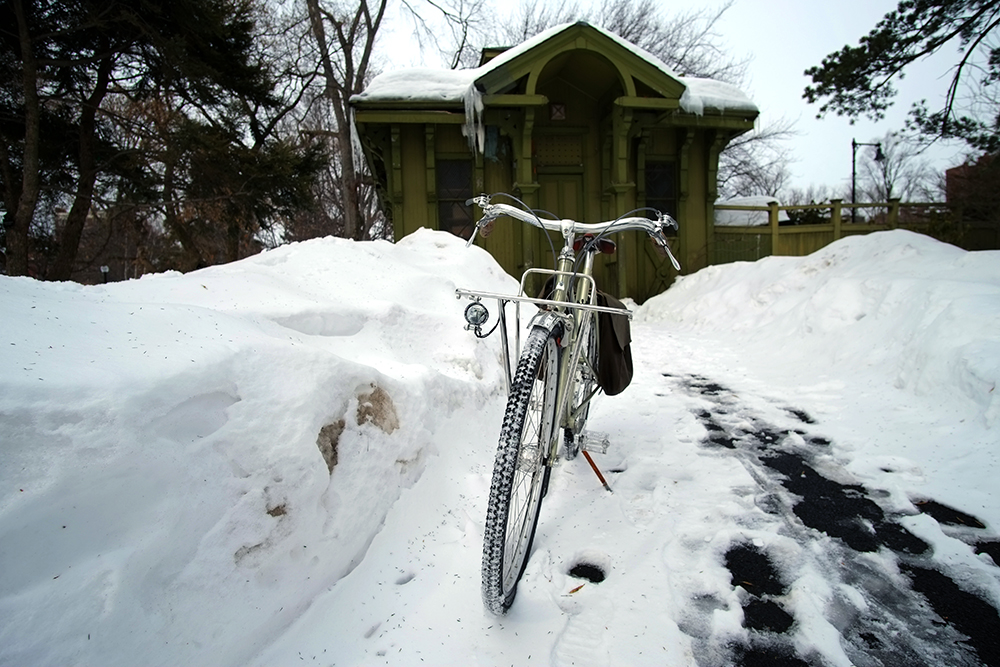
"You do not realise how good you have it there," I was warned as I packed for my flight apprehensively. And in a sense they all had a point: My current appreciation of springtime in Ireland is certainly enhanced by having spent the first half of March back in Boston, immersed in the sort of deep winter one might expect in January - and even then, only once in a great while. It was the sort of winter you'd tell your great-grandchildren about. And they would roll their eyes behind your back - because they'd only half-believe what you were telling them, and because you'd tell the goddamn story so many times. "It was a terrible, formidable winter indeed!..."
It was a winter that now stretched into March, ready to embrace me with its frigid open arms. Our landing was delayed at Boston Logan, the airplane forced to circle aimlessly while the runway was hectically shoveled again, as fresh snow had already covered it since the previous shoveling.
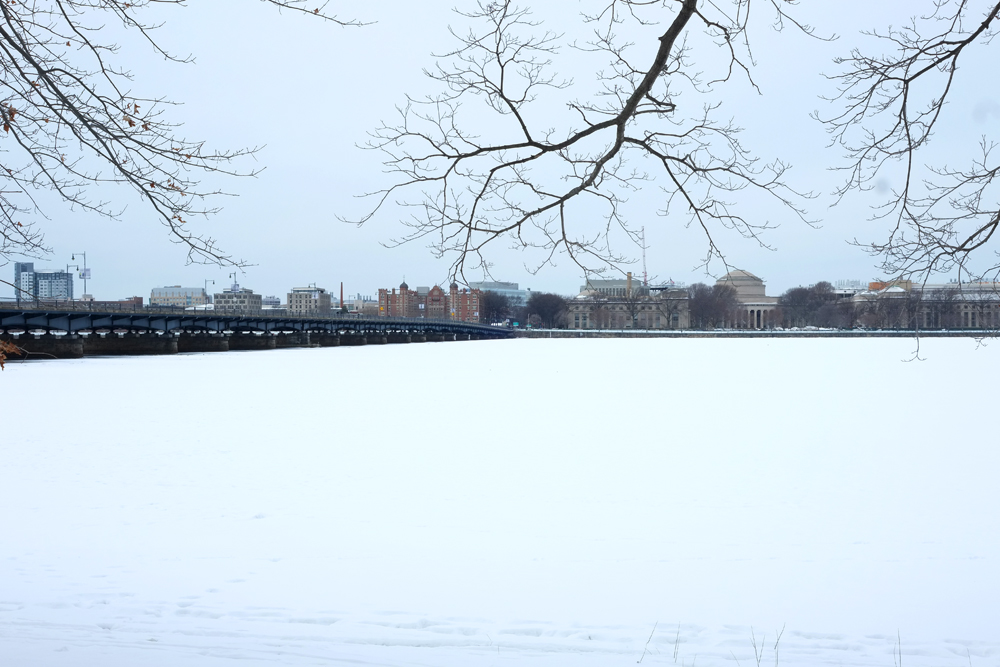
But I was well prepared for what awaited me. I had watched enough news footage to expect the solidly frozen river, and the roads encrusted with gritty hard snow.
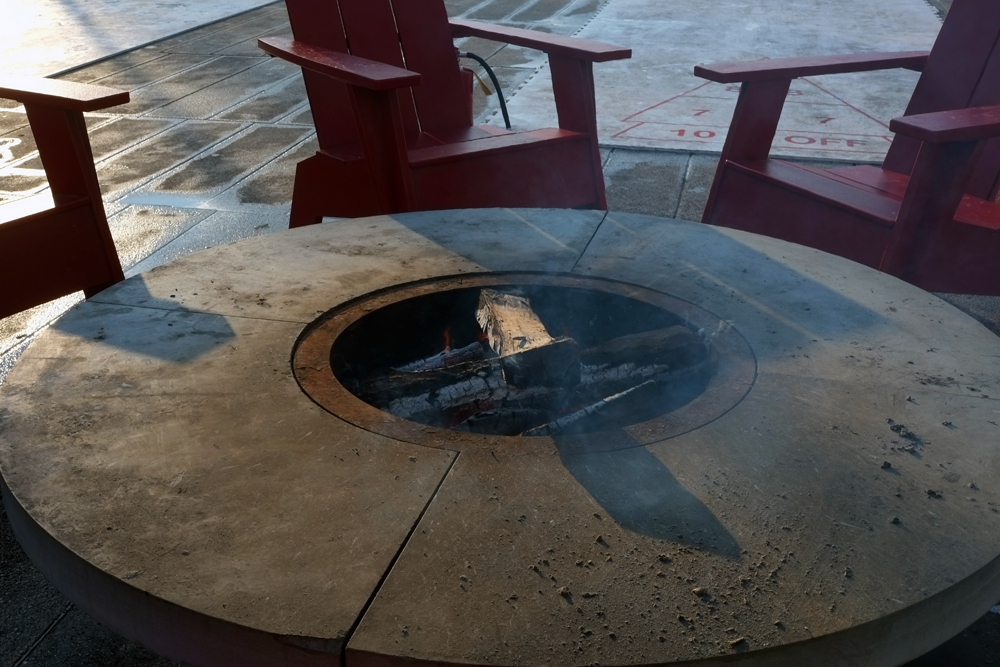
I had heard enough complaints from friends to brace myself for the freezing temperatures.
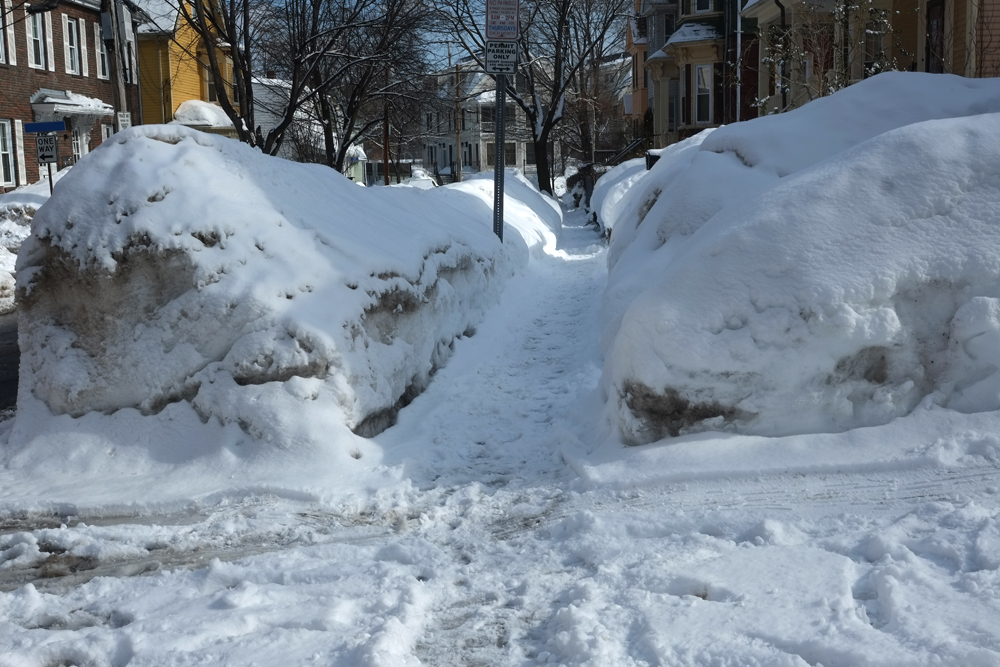
I had seen enough photos to anticipate having to make my way along tunnel-like sidewalks carved through snowbanks taller than me in height, seeing nothing around but walls of white, till it came time to cross the street.

All of this made me resign myself in advance to a stay that would not involve cycling. I'm a reasonable person, you see. And it's not all about the bike, after all.
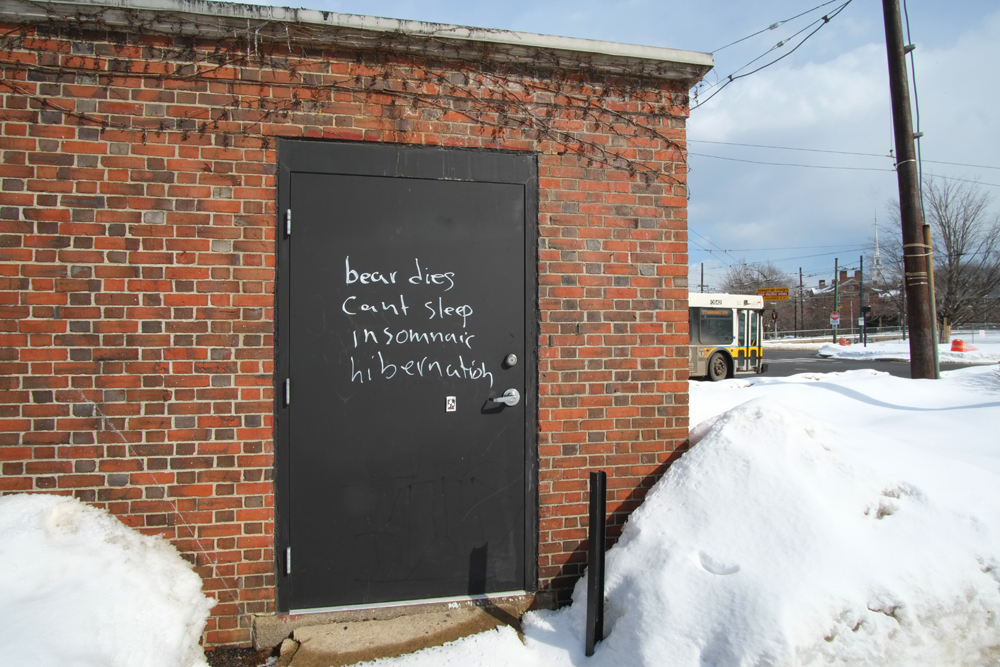
But less than a day after my arrival a couple of things made me change my mind. First, seeing other cyclists out on the roads. Not many, but enough to suggest that I could probably handle it also. But what really hastened my resolve, was an attempt to take public transportation. Freshly off the proverbial boat, my first morning back I naively boarded an MBTA vehicle in hopes that it might deliver me roughly where and when its itinerary suggested it would. I prefer not to go into the details of what happened instead, other than to say it made me renew my pledge to never set foot inside one of these vehicles again.

Still reeling from the trauma of the MBTA experience, I stumbled into HUB Bicycle in Inman Square, where some of my bikey things sit in storage in my absence (this is a service they offer, FYI).
"Maybe I'll take my city bike while I'm here," I said, "though I'm not sure how much riding I'll actually do given these conditions."
And just as the lonely machine was retrieved out of storage I saw something dangling off its handlebars that I had all but forgotten I owned: a pair of studded tires! The universe had spoken.
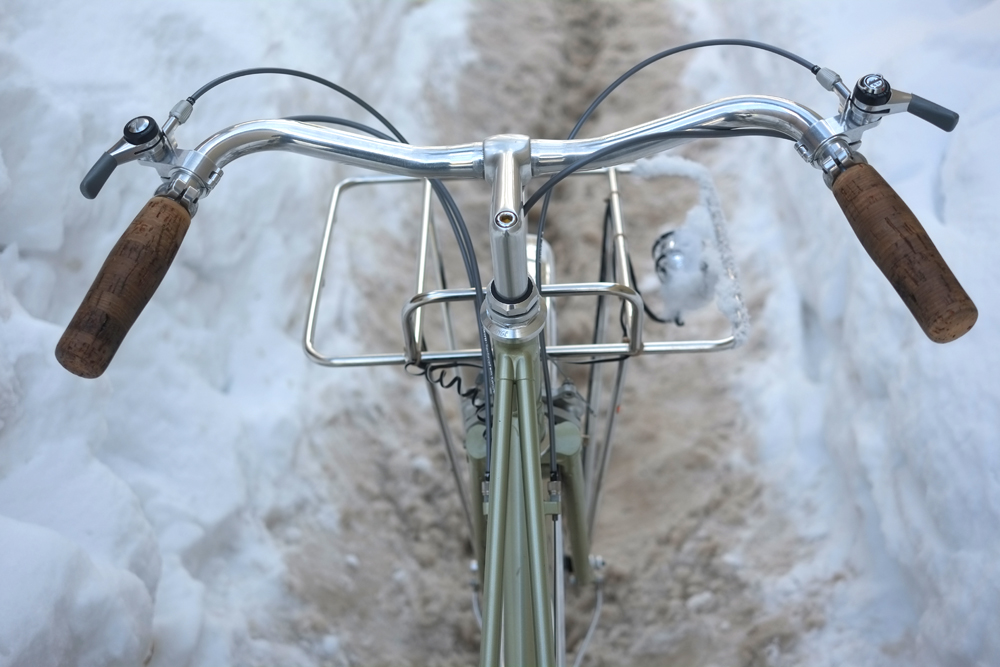
So... wow, studded tires, eh?
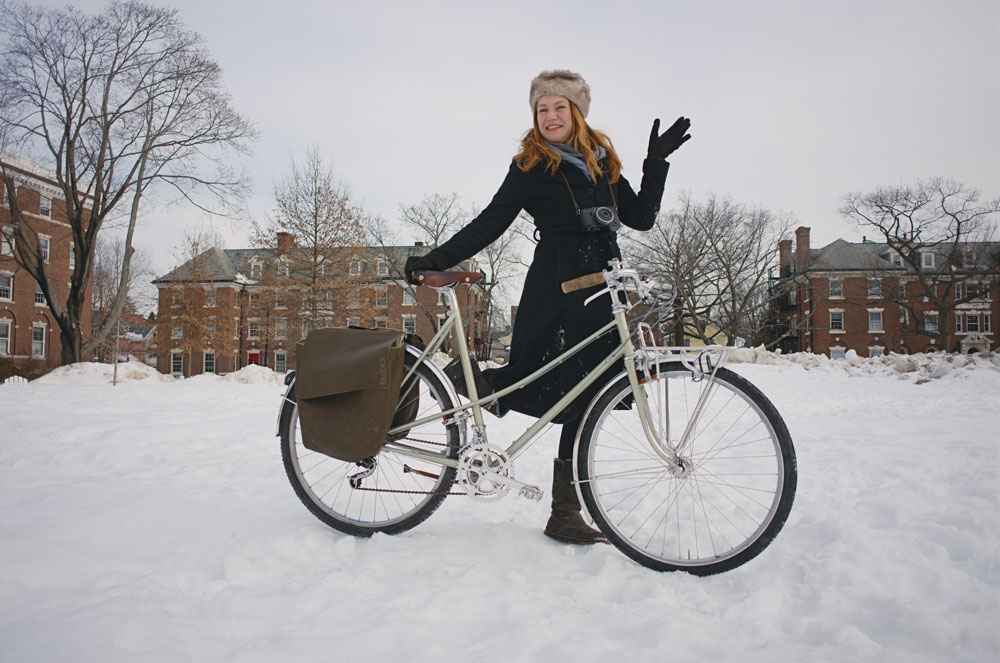
No, really, I mean wow, studded tires - they are fantastic! I want to say that I'm an idiot for not having tried them sooner. But to be fair, none of the winters I'd lived through in Boston previously were actually bad enough to warrant them.
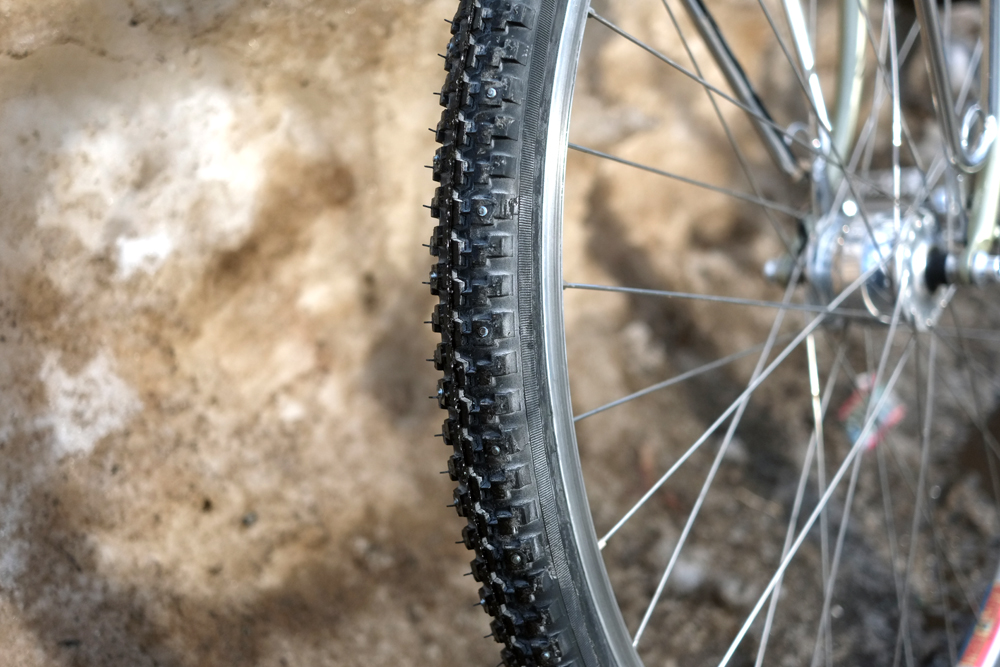
In fact I bought these tires before the winter of 2012 in case I would need them, but never had occasion to use them. They are Nokian Hakkapelitta 650B Studded Tires from Harris Cyclery (not currently listed in this size, but will be available again in time for next winter I'm sure).
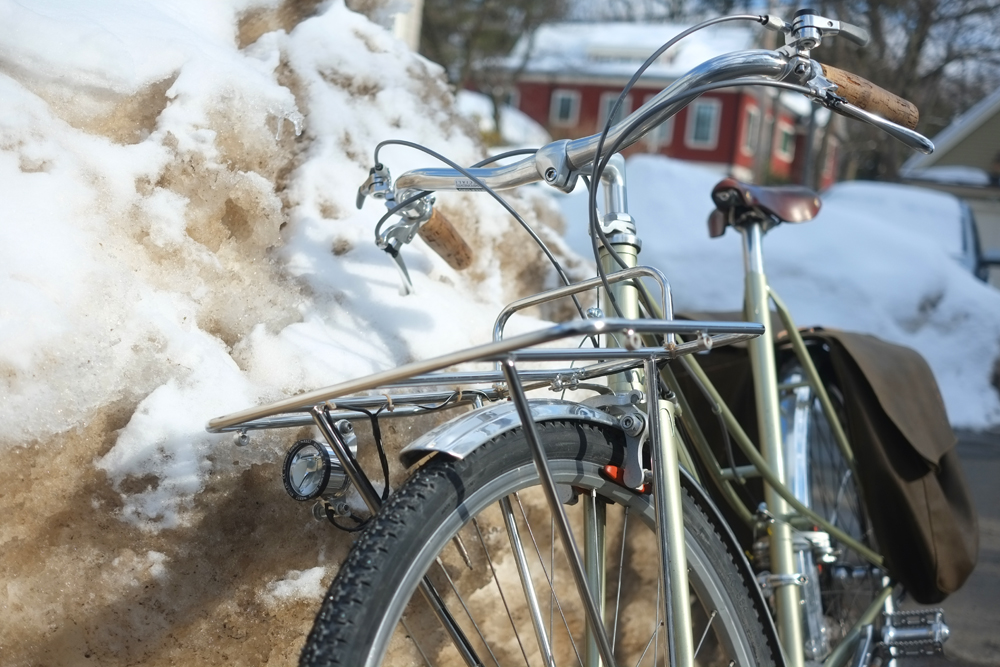
Nokian Hakkapelitta tires are made in Finland, have been around for decades, and have an excellent reputation. The 650B A10 model was recommended to me specifically, for being a convenient fit for bikes that otherwise sport 650B Grand Bois Hetres. Despite being described as 40mm in width, the 650B Hakkapelittas measure closer to 36mm. This still makes for a reasonably wide tire, while providing the additional benefit of greater under-the-fender clearance - useful for avoiding snow buildup in winter.
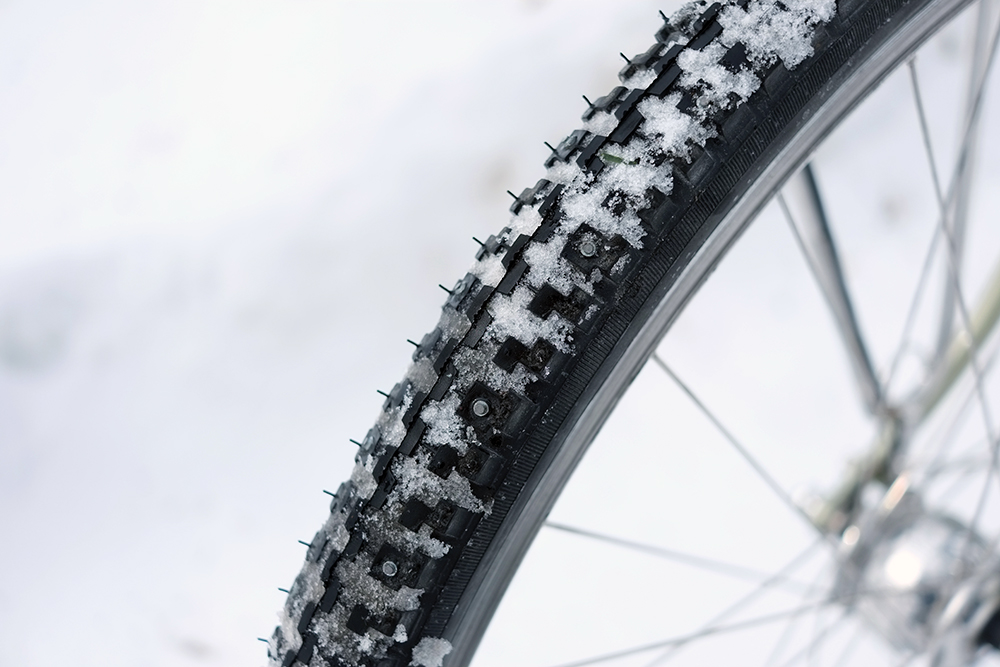
To accommodate different road conditions, studded tires are offered in varying degrees of studliness. The 650B Hakkapelittas are not a monstrous tire. Their tread and 74 carbide studs are designed for low rolling resistance. Still, they promise "incredible traction on snow and ice."
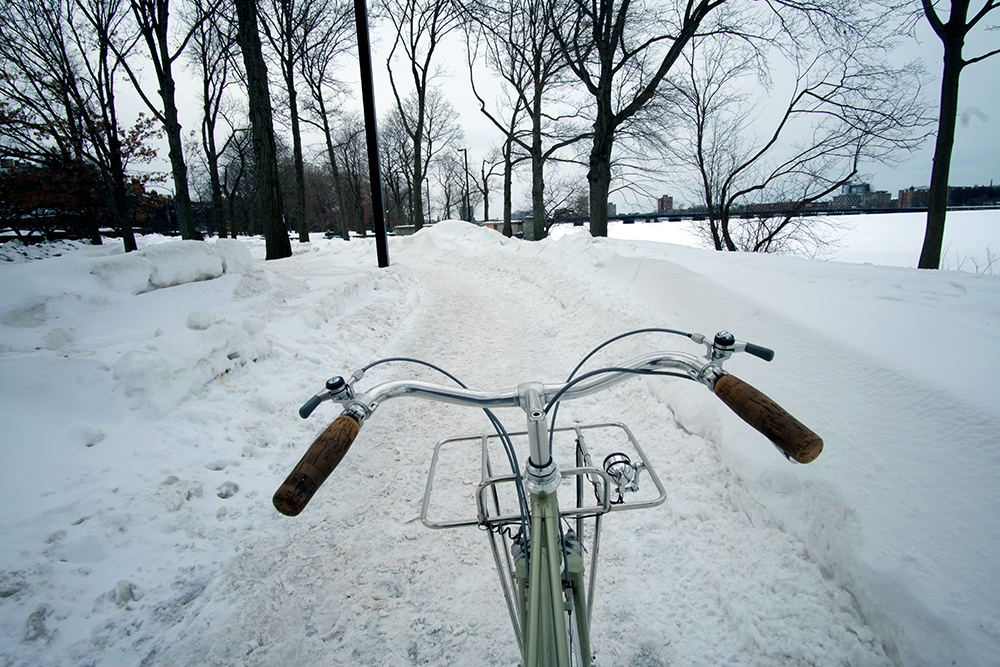
As far as traction goes, I felt the difference between these and regular tires most keenly over ice and the crusty/ uneven slippery type of hard snow. Normally these are conditions in which I would feel least comfortable cycling, but with the studded tires I hardly noticed. The tires are excellent on hard packed, even snow surfaces as well - its just that as I have no problem riding on hard packed snow on normal tires, I am less impressed with that feature. And as far as soft, deep and slushy snow, I'm not sure there was any different at all: With the studded tires, my bike fishtailed just like always in these conditions.
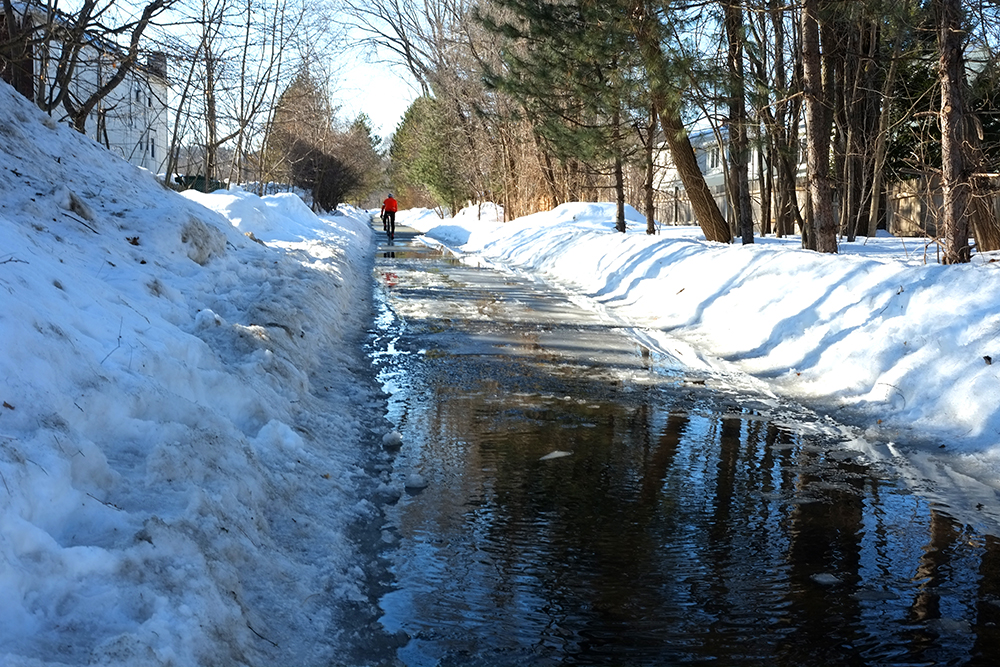
However, the tires served me well in situations where the slush or deep snow (or, later, water) concealed dangerous icy layers.
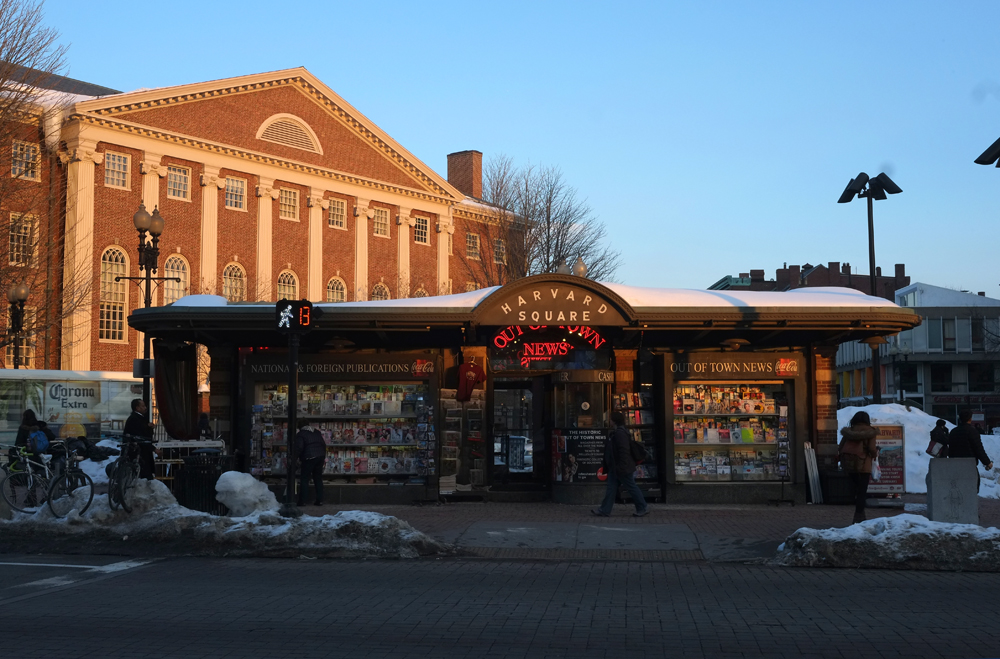
On pavement free of snow and ice, the studs made a distinct humming noise but did not feel annoyingly draggy. I was aware of being a bit slower with them than I'd normally be on the same bicycle, but that was to be expected. As was to be expected, the ride feel of the Hakkapelittas was also noticeably harsher than on the plush Grand Bois Hetres. But it wasn't too bad, and in fact not that different from many standard (non-studded) city tires. It's just that the Grand Bois Hetres do tend to spoil the rider with their exceptional comfort, so that almost anything else feels "harsher" in comparison.
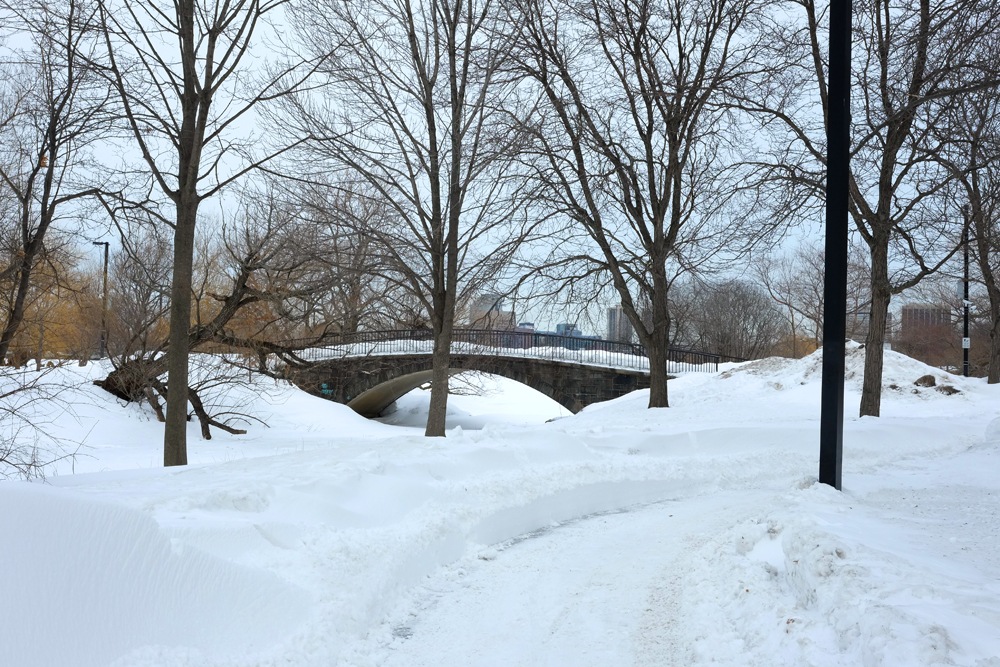
More than anything, riding on studded tires was just exceptionally exciting, as I had never tried them for any serious length of time before. It was doubly exciting to have so much freedom to roam all over the city and its outskirts despite the poor road conditions. Even when I cycled on plowed city streets, there were often unexpected stretches of ice, especially in the evenings, and not having to worry about this in traffic was liberating. Whenever I come back to Boston, my days are filled with constant administrative tasks and work projects, scheduled tightly and located all over the place. Reliable transportation is crucial, and thanks to the studded tires my bike was exactly that.
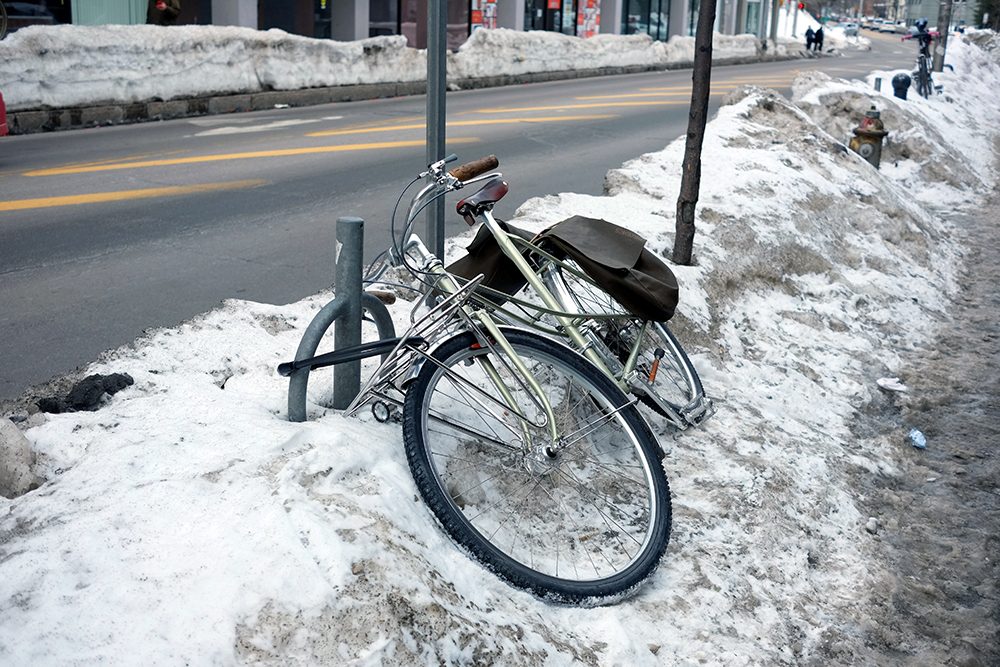
Funny enough, my biggest problem was not riding my bike but parking it. Most bicycle racks, parking meters, poles, chainlink fences, and similar, were inaccessible due to the tall snowbanks, forcing creative methods of locking up.
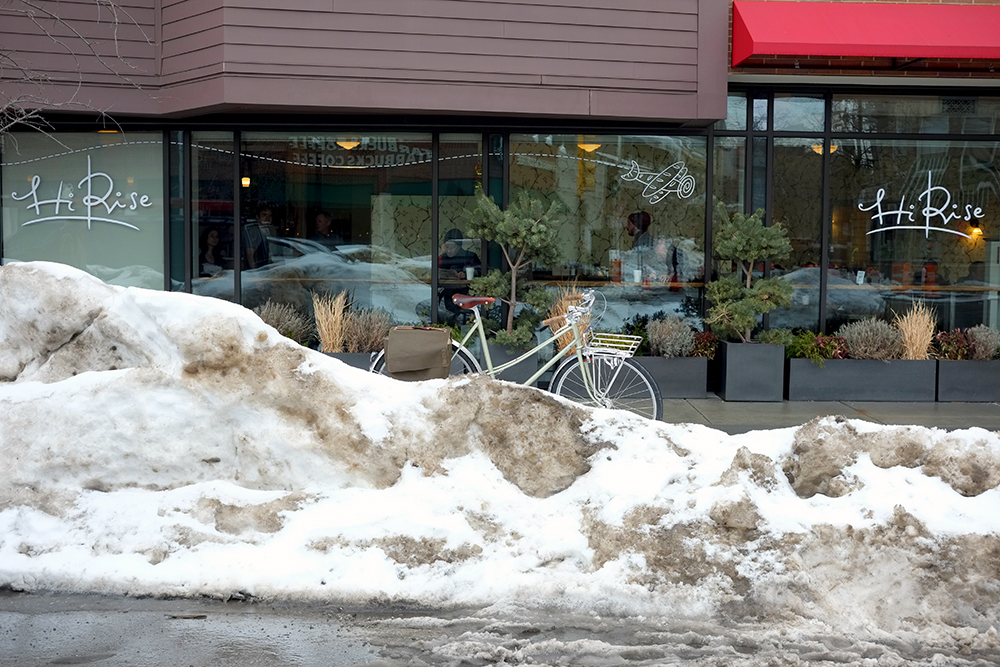
As the snow began to melt this became even more problematic, as everyone's favourite method - hoisting the bike onto a snowbank and locking it to the bit of bike rack or parking meter peeking out - became increasingly unstable, the snowbanks diminishing and changing in form by the hour.

At times, only the option of having one's bicycle guarded by lions remained feasible - a situation the lions took advantage of immediately by charging a tidy sum for the service.
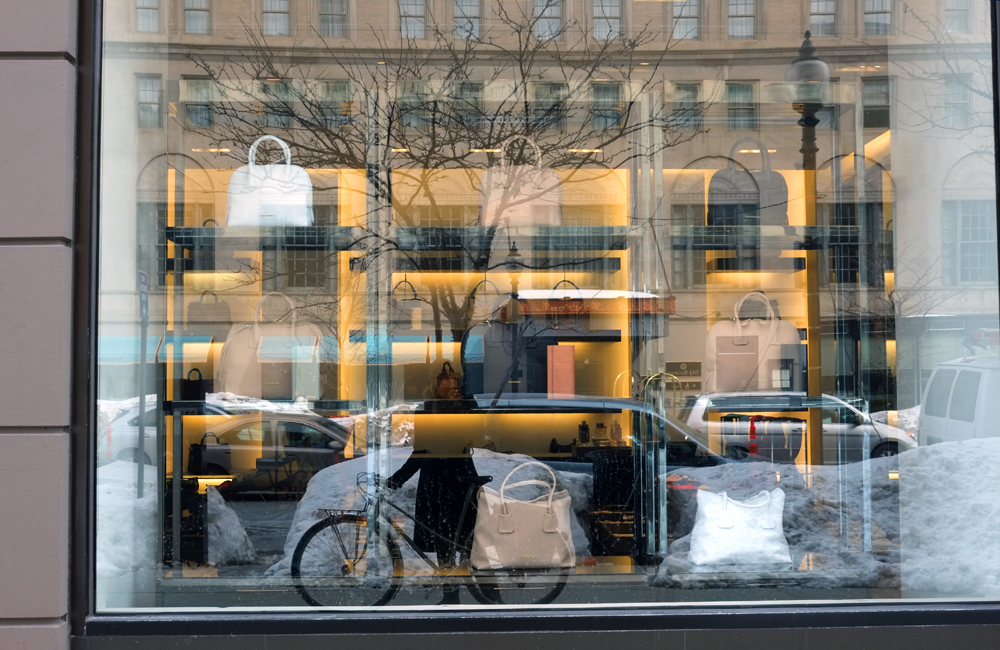
I had not expected to do any cycling in Boston, considering the snowfall and its effect on infrastructure. Instead I spent every day on my bike, racing between appointments, in a way that was ultimately not much different than it would have been in the summer. So even though I do appreciate the greenery and the sunshine of the Irish countryside, the overall effect of being back in Boston this time was rather the opposite: More than ever, I appreciate the ease with which one can zip through a well-designed mixed-traffic-use city, even in wintry conditions.
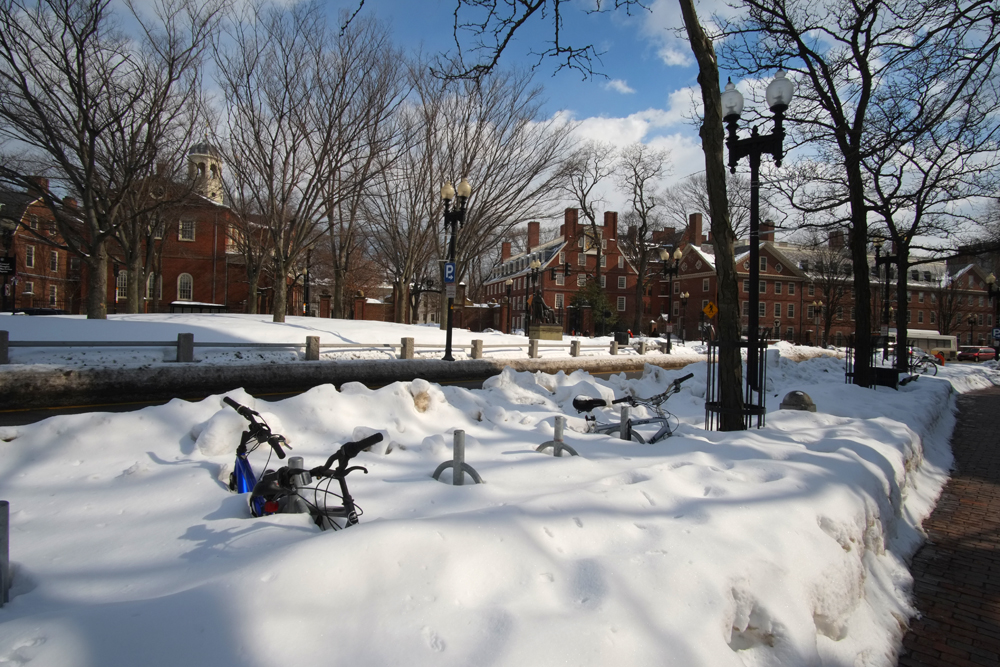
It took me two "mild" Irish winters of battling 40mph headwinds and 20% gradients, to truly arrive at that appreciation. But of course the grass is always greener. And the snow, always whiter.

Now you know why I called March to be the worst month for riding a bicycle in Boston: http://bostonbybike.blogspot.com/2015/03/whats-worst-month-for-bike-riding-in.html
ReplyDeleteYes, March means winter here and it's getting increasingly obvious that spring will come in May. But at least you were lucky not to experience truly freezing -5F weather in January.
I somehow survived this winter without studded tires. I never needed them in previous years when I rode on plowed and salted streets. This winter my commute has changed and I am using the Minuteman Bikeway every day now, which does not get salted at all making studded tires almost a necessity.
But seriously, one more winter like this and I'll probably buy a fatbike.
In previous years, I remember the end tail of winter always being the worst for cycling because of the constant thaw-freeze. There'd be less snow lying, but more surprise ice on the roads.
DeleteGood news is, fat bikes have gone mainstream - so by the time you're ready to buy there should be lots of options!
"But seriously, one more winter like this and I'll probably buy a fatbike."
DeleteStudded tires are made for those bikes, too!
Nice post. Makes natives appreciate what they have. Jim D Massachusetts
ReplyDeleteI ride with studded tires here in Vermont from mid December until early-mid March. I find that the resultant sluggishness is when I let go of a pretense of speed and and settle in for a more sedate but somewhat more relaxed experience. It's a nice change.
ReplyDeleteMy home city, Seattle, was not surprisingly listed as the dreariest city in america in a citylab.com article and my thought was "I will take our "dreary" Seattle winter to 57 consecutive blizzards any time - i'm looking at you Boston, you poor bastards" Ironically its been rather mild and sunny this winter in Seattle. Sorry. Studded bike tires were easy to find in Seattle in 2009, the year after our great "Snowpocalypse" of 2008. I predict they will be abundant in Boston next fall.
ReplyDeleteFinnish studded snow tires are good? Unbelievable!
ReplyDelete-- Juha Kankkunen
Not much to say on the subject (except very tired of winter) but I would like to comment again on how much I enjoy your blog. Yours is the only blog I look forward to, and I check for a new post every day! LOVE your blog.
ReplyDeleteDoes your bike have an internal hub? I find my cross/utility/gravel bike to be fairly intrepid when equipped with studded tires, but a warm slushy day followed by freezing evening temperatures cause my drive train to ice up, leaving me riding a single-speed. One day, returning home in a storm, I found the drive train would seize up every time I paused at a stop sign and I had to jump on the pedals to break it loose again. I don't know if having real fenders would have helped or made the situation worse; I was running only a seatpost-mounted plastic racing fender.
ReplyDeleteI have a couple of IGH bikes, but the bike in the photos is derailleur geared. I rode this particular bike through one full Boston winter (2012-2013), and its drivetrain never froze. Neither did it freeze in the course of this trip. However, I did own an old Motobecane mixte a few years back - a late 70's 10 speed - and when I tried riding it in the winter the derailleur would get iced over constantly. Not sure what to attribute the difference to.
Deletewhat is an IGH bike??
DeleteSorry - internally geared hub.
DeleteI think the majority of riders would disagree with my approach, but I have a beater 10-speed I used a lot this past winter and I worked WD40 into the shifter cables to make sure they didn't stick and I covered the derailleur in WD40 as well - of course, that was because it was a junk bike with junk parts that I didn't care much for. Yes, it did get very dirty and cleaning it up last week wasn't fun, but it at least stayed slippery enough to shed water and ice. It never once got stuck.
DeleteDerailleured and lain on its right side - for shame.
DeleteNormally I wouldn't. But the slope angle + wide rear rack meant no drivetrain contact. Placing it on the other side would have been more awkward to lock due to shape and slope of snowbank.
DeleteWD40!!
DeleteV…you're still a newbie. don't !!!!
DeletePeople always ask me how I manage to get around in the snow, but I find that sort of ironic because if anything the snow affects a bicycle commuter less than most other people. This winter was particularly bad for public transit failures, for parking spaces being few and far between, and general traffic chaos resulting in car trips taking several times as long as they usually would. But even though it's harder to find things to lock a bike to, there's usually something. And you can pick your way around traffic jams when you need to. And they do a good enough job at clearing roads that they're generally rideable, even in the middle of a storm and even when driving might pose a real risk of getting stuck somewhere (if you run into deep snow on a bike the worst that happens is you carry your bike around it and keep riding). Actually, I still went about most of my normal routine and rode to work or somewhere else during every major storm this year.
ReplyDeleteSo my answer to that question is that actually, I've never appreciated commuting by bike as much as I did this winter.
"if anything the snow affects a bicycle commuter less than most other people... I've never appreciated commuting by bike as much as I did this winter."
DeleteAlbeit within a much shorter time span, this was certainly my experience. Any time I tried a different form of transportation, something would go wrong. But the bike was just the same as always.
I live in the suburbs outside Boston, where there is a shoulder - i.e. the bike lane, and cyclists (including skilled and fast roadies) generally ride there. In February it was all covered in snow. That's 3 to 5 feet on both sides of the road for cyclists to ride that disappeared - so it's not just about the bitter cold and the slush and ice on the road and studded tires, it's that there is very little room to ride. For example, Beacon Street, and Commonwealth Avenue, two major roads that lead from the suburbs into Boston, had no bike lane. To ride a bike, you had to be very skilled, like Miss OBrien, and very comfortable taking the lane for an entire commute - which I am not, or you ride next to the snow bank, with cars brushing right past you, and no margin for error - and you can do all this in the dark, as February has less daylight. Maybe it was cleared better in the city (where many bike lanes are the door lane next to parked cars anyway), but in the suburbs the major road were very narrow - barely room for cars going one way.
DeleteAlso, I think you would have had a harder time if you had come in February. I didn't ride in February, and resumed in the beginning of March, as more space appeared on the roads, and yes I saw more cyclists in March, which encouraged me as well. Ice was still an issue for those who commute very early or late, less so during the day, and daylight savings helps for the evening commute. And I don't thing the end of January through February was as awful as some make it out to be, but it was bad or cycling.
All this is to say that it isn't fair to say riding was easy, or only a mater of the right tires.
My skill level is probably half way between that of a beginner and that of Ms. O'Brien. And judging by some of the photos I've seen of my 'hood from January-February, there were undoubtedly weeks during which I would have been unable to ride, had I spent all winter in Boston.
DeleteThat said, during the weeks I did spend in Boston, more than half of the roads I cycled on had snow banks instead of bike lanes or shoulders, necessitating not only mixing with traffic, but maintaining a steady line of travel even when encountering ice patches. The "funnest" was cycling over the Mass Ave Bridge, in the dark, the bike lane and a good portion of the travel lane itself eaten by snowbanks. Let's just say, I am a lot more comfortable mixing it up with motor traffic now than I was even 2 years ago!
It's true that the roads get narrower, and that this is often a problem. But I've found that on some of the narrower ones, it ironically turns into a benefit. These are the roads where in normal (non-snow) conditions there isn't quite enough room for cars to pass safely, but they think there is. I usually take the lane and move over to let people pass when I decide it's safe, but drivers sometimes get annoyed and honk or yell at me because they can't beat me to that next red light. When there's snow, it becomes so obvious that there really isn't room to pass that at least they don't act like they think it's my fault.
DeleteThat's not to say it's all roses or anything. I certainly wouldn't say this winter was "good for cycling" - just that it was even worse for everything else!
I live on Cape Cod, the Nokia A10s allowed me to ride all but 4 days for the whole winter. It was rough, but doable.Great tires.
DeleteEcho RunningBear
ReplyDeleteThis blog is just perfect - insightful and well.....just right.
I hope you're happy and doing well. Beautiful bike, BTW - compliments to the builder.
Woah, that's a beautiful bike. What kind of bars are those? I've been looking for something like that ...
ReplyDeleteAlso, after what you wrote, I might consider getting a pair of studded tires myself for next winter in Michigan. I made it through without falling with my Delta Cruisers but I'd like to have the additional confidence. Going sideways can be fun but it gets tiring when you're trying to haul up a hill, haha. Certainly nerve-wracking when it happens going down a hill. Maybe I'll get them for my beater 10-speed (my one bike without delta cruisers).
Those are Bella Ciao handlebars, a cross between Porteur and North Roads style. Not sure whether they have a consistent US distributor, but Bicycle Belle in Boston might have a spare pair or two.
DeleteIt´s the same Nokia that used to make cellphones before being crushed by iPhone. Going from vulcanized rubber to cellphones and now what. Back to rubber?
ReplyDeleteIt's a little more complicated than that. Nokia is the name of a Finnish industrial town that gave birth to a number of factories/manufacturers. Among these were Nokia Company (originally a milling factory), Finnish Cable Works and Finnish Rubber Works - the latter being the tire manufacturer. In the '60s these three businesses merged to form a conglomerate. However, in the '80s, the rubber works company left and became independent again, now named Nokian Tyres. From that point on, Nokia the communications company and Nokian Tyres followed separate trajectories. That is my understanding of it at least.
DeleteI picked up a pair of lightly used, 26-inch Nokians on Craigslist last winter, and they came in very handy, as my town received a record 100 inches of snowfall. As Veloria said, they perform very well on packed snow and glare ice, but not quite as well in deep, unpacked snow. They came in handy again this year even though we received about one third as much snow. On days when the streets were dry, I simply rode one of my other bikes because those stout, studded tires are a bit sluggish on dry pavement. I've prepared for next winter by building up a dedicated snow bike with a Sturmey Archer 5-speed internal gear hub, and hub brakes front and back to minimize rim and derailleur wear from ice and snow. Of course it will be outfitted with those ice-gripping Nokians.
ReplyDeleteBTW: That fur hat provides a smart Bike Cossack look. Very stylish.
Thank you! It's my mother's from the '70s, too tight for my massive head and is starting to shed besides - but I love it and relish the opportunity to wear it.
DeleteBeautiful photography again; I always enjoy your posts, relaxing and informative reading.
ReplyDeleteWhen I started commuting, after essentially not riding since my university days decades ago, I did a lot of reading—as if that would prepare me for the experience—and found LGRAB, and through that site, this one. I’ve been an avid reader for many, many months, and keep meaning to comment, so today I’m jumping in.
ReplyDeleteAllow myself to introduce myself …
I’ve always owned a bicycle, most recently a 2001 Cdn Tire bso. It got an annual tune up, and some years was ridden the four blocks home and not touched again.
Last year, after decades as a freelance, I finally had an in-house gig, and someplace to bicycle to! After the snow melted in April, I treated myself to fenders and a rack, essentially doubling the value of the bike, and thought I might try to ride to work once or twice.
(I actually took a trial run on a day off, to see if I could ride 6km and still work after without being too exhausted :-)
I could. I did. I rediscovered the joy!
But I was riding an ugly old bike, with my husband’s ugly old nylon panniers. I myself am old enough to have an infant granddaughter. BSO and I were neither fast nor elegant. We needed a little class, so I ordered a lovely Basil bag through a bike shop further afield.
The fateful day my bag arrived, after admiring the Bromptons and the cruisers and the Linus bikes, I thought, since I’m here, I might just have a peek at the (more affordable, if only slightly) bikes in the basement. One purred, “Buy me. Take me home.” I resisted. For months.
Finally, in Sept, I was back in that neighbourhood and had another peek. My bike was still there, still hanging on the wall; still on discount, but still priced more than some cars I’ve owned. Still said, buy me, take me home. I took it for a test drive. It was too big. Zero clearance over the bar. It wasn’t a step-though like I was sure I wanted. It was too fast. It was too scary. It was like flying.
Nice LBS people listened to me insist it was too big, and offered other bikes to try. Most were nice. Most fit better. None said buy me, take me home. I dithered and went away, and came back the next day and bought “my” bike.
Now I ride a 2012 Brodie Infinity. Not perhaps a lovely bicycle by the standards here, but it has ample gears (unlike the bso derailleur that wouldn’t even acknowledge there was a third ring), disc brakes (the bso thought I could just drag my feet), fender, rack, and I added a basket even though it destroyed the silhouette. I am enjoying it a great deal. So much so, that I bought another bike, a 2014 Kona Dr Good, which I outfitted w studded tires as a winter bike.
If someone had told me a year ago I would try biking to work and enjoy it and find ways to do more of it and even try to ride through a Cdn winter, I would have thought them mad. Yet here I am, if not a “cyclist” at least someone who gets from A to B on a bicycle.
Thanks for providing such a wonderful (smart, encouraging, informative, interesting, provocative, entertaining) site. The good and abundant advice here helped embolden me to try something I could not have envisioned otherwise, and I am very grateful.
(I’m also a bit long winded. Apologies. Won't make it a habit.)
Best,
Lil Bruin
"I myself am old enough to have an infant granddaughter...."
DeleteTechnically, so am I... as I realised last week, when a local woman aged 35 announced she is expecting her first grandchild.
But anyway. Congratulations on enduring such long winters, and on building up a winter bicycle that works for you!
What kind of grips are that? Looks good.
ReplyDeleteThey are Portuguese cork grips from Rivendell.
DeleteI know it’s late, but I wanted to weigh in re the studded tires. They are just the best thing ever! I had never biked in snow before this year, so have no basis for comparison, but the romantic fantasy of biking while fat fluffy flakes floated gently down in the light of the street lamps that made me buy a second bike as a winter bike did not include wiping out and hurting myself, so I bought a pair of Schwalbe Winter Marathons. Ice, even black ice, and packed snow were no problem at all, though that deep, heavy, brown-sugar snow was hard work. With the studded tires, it was easier to bike than to walk. They aren’t cheap, but they were certainly worth it. Mind you, it started snowing here on 2 Nov, and it isn’t completely gone even now, so I am getting my money’s worth. YMMV. Highly recommend them both for the feeling of security and for the actual difference they make to a slick, cold-weather commute.
ReplyDelete(If possible, buy them from an LBS that has hardwood floors. Rolling the bike out the door w studded tires sounds like riding on bubble wrap. Such a happy noise.)
And if, like me, you are firmly in touch with your inner child and still get a thrill stomping that crisp layer of ice atop water at the edges of paths and puddles, it is no less fun on a bike.
The tires are a keeper, but I will have to make some changes when it gets really bitter. Seems I’m good to about –20C. Below that, my fingers freeze, though with sufficient layers topped by a windproof layer and down, keeping torso (always too warm), legs, even face, etc, warm wasn’t too much bother. At least, not much more bother than warming the car and scraping windows, etc, for which you also need a windproof layer and down when it’s –30C and blowing. I have an old down-filled jacket that I am considering cutting up to make pogies. That might do it.
And I have to say, merino is a lovely thing. Not at all the itchy, smelly stuff I remember from the 80s. This is soft and warm without being hot and doesn't smell or make you smell and barely needs washing if you hang it up outside for a few hours to air every so often. (All things I learned from this site, so preaching to the choir, here, but quite the revelation for me.)
Best,
Lil Bruin
I've got the same tires for winter (cape cod). I've been riding them for about 3 winters now. They really make the difference. This winter was especially bad, and I was grateful to have them. There is no cracking in the sidewall and they seem very durable. I have only lost one stud, and from what I understand, they can actually be replaced. I found running them at 40-45 PSI worked best. Very good on ice. Read Peter White's description:
ReplyDelete"How effective are the studs?
To describe the stud's effectiveness, I'll use an analogy. Think about walking with rubber soled shoes on three surfaces; dry clean asphalt, glare ice, and glare ice that's been sprinkled with sand. On the dry asphalt you can run and make sharp turns without any concern about your shoes skidding. On the ice, you can only walk carefully, changing direction and speed slowly, lest you Fall Down Go Boom (that's FDGB for those of you, "in the know" so to speak). On ice that someone has nicely sprinkled some sand over, you can walk easily and perhaps even run. But if you do run you won't be making any sharp turns or trying to stop quickly, as you would on dry asphalt, since you know full well that those little grains of sand aren't glued onto the ice, and can roll if pushed hard enough.
Riding on ice with studded tires is like walking on ice that's been lightly covered with sand. It's pretty safe. You're not likely to fall unless you do something stupid. You're not going to have the same traction you would have on dry pavement. But you're going to have far more than you would with regular tires on ice. Keep in mind that there's ice down there and you'll be fine. Try to be a hero, and you'll probably pay a price. "
Three weeks ago in Oxfordshire I just couldn't make the bike turn on ice going around a corner on my way to work. I do not clamp my feet onto the pedals so no big deal except, I had not zipped the small pocket on the small bag on the rack on the back of my bike. Spent 15 minutes going around picking up change. Being originally from New Hampshire there was no way I would have left 1p on the road or in the bushes.
ReplyDeleteNice to see what I am missing but also good to see The Sox are undefeated !